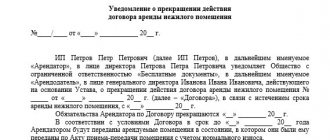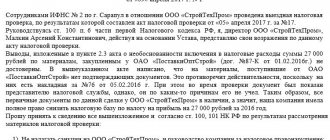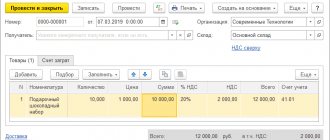One of the components of financial statements, in addition to the balance sheet and profit and loss account, is a report on the intended use of funds received. This form is submitted to the tax authority, statistics authority, and other interested parties (for example, persons who provided targeted funds).
A report on the intended use of funds received (OKUD 0710006) is mandatory to be drawn up by public organizations and their structural divisions that do not carry out entrepreneurial activities.
Other non-profit organizations draw up a report on the intended use of funds received, if necessary, and also if this is provided for in the accounting policies of the organization.
The name of some lines of the report speaks for itself, and filling them out does not present any difficulty. Let's take a closer look at filling out the report on intended use, looking at the lines the completion of which may raise doubts.
Report on the intended use of funds received or Form 6: which is correct?
As part of the current forms of annual financial statements recommended for use (approved by order of the Ministry of Finance of Russia dated July 2, 2010 No. 66n), there is a document called a report on the intended use of funds.
It is often also called Form 6, despite the fact that the serial numbering of the forms for reports given in Order No. 66n is not used, and only five report forms are given in this document. Where did the name come from, referring to the form number, and is its use legal? The origin of the name, Form 6 of the report on the intended use of funds, is due to Order No. 67n of the Ministry of Finance of Russia dated July 22, 2003 - a document that is no longer in force, which, before Order No. 66n came into force (and it became mandatory for use in reporting for 2011), approved recommendations for use accounting forms. Order No. 67n contained 6 report forms, and in each of them, under the official text name, there was an indication of the serial number of the form. The numbers were distributed as follows:
- No. 1 - balance sheet;
- No. 2 - profit and loss statement;
- No. 3 - statement of changes in capital;
- No. 4 - cash flow statement;
- No. 5 - appendix to the balance sheet;
- No. 6 - report on the intended use of the funds received.
The forms approved by Order No. 66n do not have an indication of the form number, and only five forms themselves are given in this document: the form corresponding to the appendices to the balance sheet is excluded from them. However, for accountants who compiled reports for the years preceding 2011, the use of numbering of the compiled forms, which simplifies the indication of their name, remained common. However, such a reference can only be used informally, since the current document approving the accounting forms does not contain report numbers.
IMPORTANT! When preparing reports for 2021, keep in mind that accounting forms, incl. Forms 6 have changed. Key differences: reporting can only be prepared in thousands of rubles; millions can no longer be used as a unit of measurement. OKVED has been replaced by OKVED 2. For other changes, see here.
Responsibility
Initially, the collection of a fine threatens those enterprises that, in the course of their activities, used funds for the intended purpose as inappropriate.
According to Article 1 No. 126 of the Tax Code of the Russian Federation, all enterprises obligated to perform these actions, including non-profit organizations, are held liable for failure to submit a package of documents on the balance sheet report or for submitting it incompletely.
The amount of penalties will be affected by the size of the submitted package; if the list of documentation is incomplete, a fine of 200 rubles will be charged for each missing form.
Reporting on the intended use of funds: who submits it?
So who is required to submit a report on the intended use of funds?
In Order No. 67n, the answer to this question was unambiguous: Form 6 was recommended to be drawn up by non-profit organizations (clause 4 of the instructions on the scope of accounting forms). A similar recommendation (albeit with a slightly different wording, referring to public organizations that do not conduct entrepreneurial activities) was also in the original version of Order No. 66n (subparagraph “c”, paragraph 1). But at present (Order of the Ministry of Finance of Russia dated December 4, 2012 No. 154n) there is no indication in the text of Order No. 66n as to who is affected by the preparation of a report on earmarked funds. Thus, this form must be drawn up by all recipients of targeted funding, i.e. not only non-profit structures, but also commercial organizations receiving targeted funds.
Organizations that do not receive targeted funds do not prepare a report on them, since they do not have the data to fill it out.
If you use the simplified tax system, find out from ConsultantPlus which forms of accounting in addition to Form 6 you need to submit to the Federal Tax Service. If you do not have access to the K+ system, get trial online access to the system for free.
Options for a report form on the intended use of funds
The report form recommended for use on the use of targeted funds does not exist in a single version. Order No. 66n approved two of its forms:
- complete, given in Appendix No. 2.1;
- simplified, contained in Appendix No. 5.
Simplification implies a reduction in the number of lines in the report by combining data on a number of indicators (subparagraph “a”, paragraph 6 of Order No. 66n) and the absence in the form of a column intended to indicate the number of explanations.
The simplified form can be used by persons who have the right to simplify accounting and the formation of simplified accounting records. These persons include (Clause 4, Article 6 of the Law “On Accounting” dated December 6, 2011 No. 402-FZ):
- small businesses that meet the criteria specified in the law “On the development of small and medium-sized businesses...” dated July 24, 2007 No. 209-FZ;
- non-profit organizations subject to the Law “On Non-Profit Organizations” dated January 12, 1996 No. 7-FZ;
- participants of the Skolkovo project who received this status in accordance with the law “On the Skolkovo Innovation Center” dated September 28, 2010 No. 244-FZ.
The simplified form 6 can be downloaded from ConsultantPlus. To do this, just get a trial demo access to the K+ system. It's free.
Simplification of reporting is not available (Clause 5, Article 6 of the Law “On Accounting” dated December 6, 2011 No. 402-FZ):
- for legal entities required to audit their accounting records;
- housing and housing-construction cooperatives;
- credit consumer cooperatives and microfinance organizations;
- public sector organizations;
- political parties;
- associations of lawyers and notaries, legal consultations;
- non-profit structures acting as a foreign agent.
Procedure for filling out the intended use report
The procedure for filling out a report on the intended use of funds is not separately described anywhere. The logic for entering data into it follows from the content of the report itself and the notes available under the main table.
The main table is preceded by data about the reporting entity (its name and codes characterizing basic information about it: OKPO, INN, OKVED, OKOPF, OKFS), as well as information about the year for which the report is being prepared, the date of creation and the applied unit of measurement of the entered indicators.
The purpose of filling out the main table is to reflect, taking into account the analytics of receipts and disposals, the process of changing the balance of target financing funds accounted for in the organization (when applying the chart of accounts of accounting, approved by order of the Ministry of Finance of the Russian Federation dated October 31, 2000 No. 94n, they are shown on account 86). In this case, a comparison of data from the current and previous years is provided.
The top and bottom rows of the table indicate information about fund balances, respectively, at the beginning and end of the year. Intermediate lines are divided into two groups: with information about receipts and about the expenditure of funds received. For each of the groups, the forms given in Order No. 66n offer a specific breakdown of analytical lines, focused on the most frequently occurring reasons for receipts and expenditures. In full form, for these reasons, the following are highlighted:
- in receipts - lines: for entrance, membership and target fees;
- voluntarily contributed funds;
- income resulting from the activities of the reporting entity;
- other funds received;
- for the purposes for which the legal entity received appropriate funding, highlighting information about expenses for charity and social assistance, informational events, and other procedures;
In a simplified form, revenues combine data on contributions and voluntarily contributed funds, and in expenditures there is no detailing of the four main groups of lines. In addition, the simplified form is distinguished by the absence of total figures related to income and expenses.
At the same time, if necessary, the report writer can supplement the form proposed by Order No. 66n with the required number of lines (clause 3 of Order No. 66n).
Explanations and an example from ConsultantPlus will help you fill out the new Form 6. If you do not yet have access to this legal system, sign up for a free trial.
Features of simplified taxation
The simplified method of taxation refers to the method of accounting in the HOA, in which the tax base is defined as the difference between income and expenses, and the tax rate is 15 percent. Taking into account only the income part at a rate of 6 percent as a method of calculating tax under the simplified tax system in housing organizations is not used.
Housing associations that have switched to a simplified tax calculation system must report annual income and expenses by submitting a tax return before the end of March of the year following the reporting year, in accordance with paragraphs. 1 clause 1 art. 346.23 Tax Code of the Russian Federation.
IMPORTANT! Housing associations paying taxes according to the simplified tax system are required to take into account current income and expenses in special accounting books (Article 346.24 of the Tax Code of the Russian Federation).
The housing association pays tax under the simplified system once a year, but reports must be submitted every three months, starting from the beginning of the calendar year , while making advance payments according to the accrual system.
The reporting is sent to the tax service department by the accounting staff of the HOA or members of the board.
An example of filling out a report on intended use
Let's look at an example of filling out a report on the intended use of funds using specific figures.
Example
For the Nadezhda charitable foundation, which is engaged in helping people who find themselves in difficult life situations, the main source of funds that allows them to carry out the activities provided for in the charter are voluntary donations from legal entities and individuals. The balance of unused funds at the beginning of the year amounted to 30,000 rubles. In 2021, the fund received 7,000,000 rubles as voluntary donations.
In addition, the foundation organizes educational events that generate income from the sale of entrance tickets to them. The net profit from this activity for 2021 amounted to RUB 1,000,000.
The expenses incurred by the fund in 2021 were as follows:
- for charitable payments to people who find themselves in difficult life situations - 6,400,000 rubles;
- for wages, taking into account insurance premiums accrued on the amount of the employee’s income - 1,400,000 rubles;
- for business trips to check the reality of difficult life circumstances for people who need help - 70,000 rubles;
- for cosmetic repairs of premises occupied by the foundation on a lease basis - 100,000 rubles.
The situation was similar in 2021. That is, there were two types of income: voluntarily donated amounts (5,500,000 rubles) and profit from business (900,000 rubles). Funds were used for charitable payments to people in need (5,200,000 rubles), wages and insurance premiums (1,100,000 rubles) and business trips (80,000 rubles). Unused funds at the beginning of the year amounted to 10,000 rubles.
In the main table of the report, fund balances at the beginning of the year will be shown in line with code 6100, and balances at the end of the year - in line 6400. Moreover, the data in line 6100 for 2021 (at its beginning) and line 6400 for 2021 (at its end ) must be the same.
Receipts will be reflected in lines 6230 (voluntary donations) and 6240 (profit from business). Their total amount will appear in line 6200.
In relation to expenses for targeted activities, lines 6310 will be used (it will show their total value) and 6311 (it is intended for expenses in the form of charitable assistance).
As for the costs of maintaining the fund itself, lines 6320 will be used (their total amount will be reflected here), 6321 (expenses related to wages), 6323 (travel expenses) and 6325 (property repair expenses).
The total amount of expenses incurred, equal to the sum of lines 6310 and 6320, will fall into line 6300.
The balance of funds at the end of each year is calculated from the amount of their balance at the beginning of the year by adding the total amount of receipts and subtracting the total amount of expenses from this term, i.e. according to the formula (if compiled using report line codes): 6100 + 6200 - 6300 = 6400.
Please see the completed report on our website.
Structural design
Includes four sections. Each of them must be filled out. The structural organization is worth taking a closer look at.
- The 1st part is called “Opening Balance.” It shows what funds the company has from the above sources at the beginning of this tax period, as well as what amount it had at the end of the previous period.
- The 2nd part indicates “Funds Received”. The name speaks for itself; here we display all the financial income of the company.
- The 3rd part is called “Funds Used”. It not only reflects how much was spent, but also the purposes for which the expenses were spent. The list of goals begins with the implementation of targeted types of events, such as charity events, and ends with the costs of retaining the management staff.
- Part 4 “Balance at the end of the year.” This section displays those funds that the company did not use in this reporting period. That is, which remained on the accounts.
Results
A report reflecting information on the dynamics of targeted financing funds is generated if the reporting entity has such funds. When creating it, the form recommended by the Ministry of Finance of Russia is usually used, which has two forms (full and simplified) and, if necessary, can be supplemented with the necessary lines. Simplification of the report is achieved by combining indicators and is not available to all users of this form. There are no special instructions for filling out the current form, so you need to enter data into it based on the logic of the report form itself.
Sources:
- Federal Law of December 6, 2011 No. 402-FZ
- Order of the Ministry of Finance of Russia dated July 2, 2010 No. 66n
You can find more complete information on the topic in ConsultantPlus. Free trial access to the system for 2 days.
How to fill
The preparation of the document begins with information characterizing the enterprise itself. After this, you must provide information according to the sections, namely:
- balance of funds from the previous reporting year;
- availability of new arrivals;
- costs that are directly related to this type of funds;
- targeted use of budget funds.
Then calculations are carried out for all sections, and the resulting indicators are entered in a column that displays the result information.
It is important to remember that there are situations when the amount of costs exceeds the amount of income. In this case, the resulting information, as well as possible other negative indicators, should be written in parentheses, which indicate a negative amount.
A similar situation that has arisen should not remain uncommented, therefore it is imperative to provide explanations that describe the reason for the formation of negative indicators and the step-by-step procedure for correction.
The generated report is subject to mandatory certification by the chief accountant and management of the enterprise. Be sure to include the date the document was compiled at the end.








